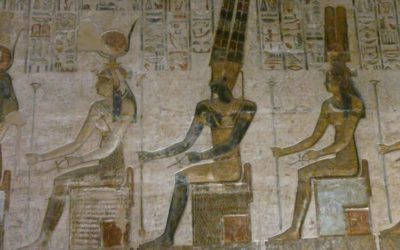One of the greatest civilizations the world has ever seen, the Ancient Egyptians ruled over the lower reaches of the Nile for millennia. After a unified kingdom arose around 3100 BC, a series of dynasties and pharaohs built ever-bigger pyramids and temples before falling to the Roman Empire in 30 BC.
During this incredible long era, the ancient Egyptians produced some of the most famous monuments in the world of which many have survived the ages. Many of the massive monuments were dedicated to various deities or the pharaohs themselves and were adorned with rich decorations, such as striking statues and detailed reliefs.
Such was the ingenuity and engineering prowess of the Ancient Egyptians, many of these amazing ancient monuments are still standing today. Here’s a look at the most amazing ancient Egyptian monuments:
10. Temple of Hatshepsut

Not far from the famed Valley of the Kings lies another of Egypt’s incredible ancient sights; the Mortuary Temple of Hatshepsut. Located at the foot of towering cliffs that rise dramatically above the desert floor is a massive, almost modern-looking monument.
Built for the female Pharaoh Hatshepsut who died in 1458 BC, the temple boasts three layers of terraces, all of which are lined by colossal colonnades. Once surrounded by lush gardens, they are connected by long ramps with well-preserved and colorful reliefs of animals, plants, and people to be found alongside huge statues of Osiris.
9. Bent Pyramid

One of the greatest civilisations the world has ever seen, the Ancient Egyptians ruled over the lower reaches of the Nile for millennia. After a unified kingdom arose around 3100 BC, a series of dynasties and pharaohs built ever-bigger pyramids and temples before falling to the Roman Empire in 30 BC.
During this incredible long era the ancient Egyptians produced some of the most famous monuments in the world of which many have survived the ages. Many of the massive monuments were dedicated to various deities or the pharaohs themselves and were adorned with rich decorations, such as striking statues and detailed reliefs.
Such was the ingenuity and engineering prowess of the Ancient Egyptians, many of these amazing ancient monuments are still standing today. Here’s a look at the most amazing ancient Egyptian monuments:
10. Temple of Hatshepsut

Not far from the famed Valley of the Kings lies another of Egypt’s incredible ancient sights; the Mortuary Temple of Hatshepsut. Located at the foot of towering cliffs that rise dramatically above the desert floor is a massive, almost modern-looking monument.
Built for the female Pharaoh Hatshepsut who died in 1458 BC, the temple boasts three layers of terraces, all of which are lined by colossal colonnades. Once surrounded by lush gardens, they are connected by long ramps with well-preserved and colorful reliefs of animals, plants, and people to be found alongside huge statues of Osiris.
9. Bent Pyramid

8. Step Pyramid of Djoser

7. Luxor Temple

6. Great Sphinx
5. Red Pyramid

4. Valley of the Kings

3. Abu Simbel

2. Karnak

Other than the pyramids, the most popular place to visit in Egypt is the captivating Karnak Temple complex which lies in Luxor on the banks of the river Nile. Built over millennia, this site has everything from colossal colonnades and chapels to sumptuously sculpted sanctuaries, sphinxes, and obelisks.
Although construction began around 2000 BC, later pharaohs added their own flourishes making Karnak now the largest ancient religious site on earth. As such, exploring the archaeological area is an incredible experience with such spellbinding sights as the Great Hypostyle Hall in the Temple of Amun-Ra.
1. Pyramids of Giza

Arguably the world’s most famous landmark, the Pyramids of Giza lie on the outskirts of Cairo, looking out over the endless sands of the Sahara. The pyramids in Giza were built over the span of three generations – by Khufu, his second reigning son Khafre, and Menkaure. The Great Pyramid of Khufu is the oldest and sole remnant of the Seven Wonders of the Ancient World.
Over 2 million blocks of stone were used to construct the pyramid, during a 20 year period concluding around 2560 BC. The pyramid is awe-inspiring 139 meters (455 feet) high making it the largest pyramid in Egypt, although nearby Khafre’s Pyramid appears to be larger as it is built at a higher elevation.


